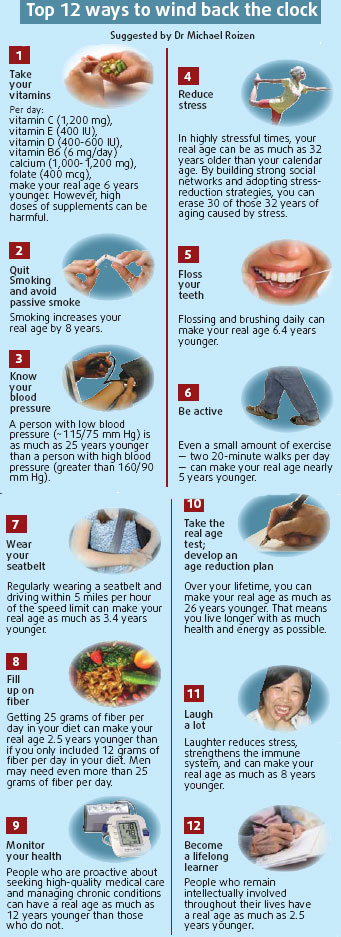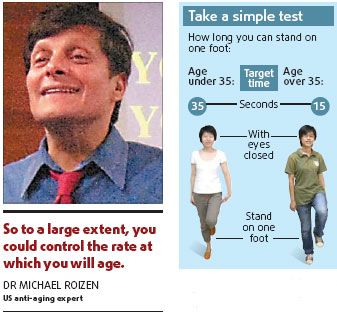How old are you really?

He is an anti-aging expert, a best-seller author and an experienced internist. But Dr Michael Roizen does not care what people call him as he only has a single goal: To help motivate people to get healthier.
Last week, still in high spirits after attending an international conference held in Beijing, Roizen came to a community residence in the southern suburbs of Beijing and lectured young people about the science of age reduction.
Dr Roizen, an internist and anesthesiologist at the Cleveland Clinic, Ohio, the United States, pioneered the concept of real age. And he started discussing it publicly in 1993.
Roizen's first book on the topic, Real Age: Are You as Young as You Can Be? came out in 1999 and became a New York Times best-seller. In the book, 140 things were mentioned to make people younger and change the rate of aging. For example, Roizen suggests that people take simple steps like drinking less alcohol, eating more vegetables and taking vitamins.
Now 61 years old, Roizen says his biological age or real age is only 42.
According to him, chronological age is how old one is in calendar years. Comparatively, biological age, or real age, is how old the body is based on lifestyle, medical history and genetics.
To calculate real age, Roizen worked with doctors, epidemiologists and scientists to design the Real Age Test to weigh each individual factor in one's profile, from medical history and current health conditions to exercise, nutrition, daily habits and stress. After completing the quiz of 190 questions available on Roizen's Realage.com, the biological age of one person can be calculated.
Roizen says the test can persuade patients to adopt healthier habits or drop bad practices like smoking, which can add the equivalent of eight years to a person's biological age.

There are also some simple tests you can do to see whether you are healthy or not. For example, stand on one foot with the eyes closed and see how long you can stand.
According to Dr Roizen, you should stand at least 35 seconds if you are under the age of 35. For people over the age of 35, they should be able to stand 15 seconds.
"If you could not, it says that you are a bit older physiologically," he says.
You could also pinch your skin and see how fast it returns, which is also a sign of the aging body.
According to Dr Roizen, several components are thought to contribute to aging: diseases in the artery and immune system, decay of nerve cells, damage to genes, inefficient energy production in the cells and effects of accidents and environmental factors.
For example, arterial aging is the root cause of heart attacks, strokes, heart disease and many other conditions. Immune system aging is associated with cancers and autoimmune diseases such as arthritis. Accidents contribute to premature disabilities and death.
Dr Roizen believes that cardiovascular disease and cancer are not just a matter of genetics, they are actually preventable. For example, 70 percent of arterial aging is considered preventable; 80 percent to 90 percent of all cancers are likely due to environmental causes, such as exposure to toxins or poor diet; 80 percent of all accidents may be avoidable.
"So to a large extent, you could control the rate at which you will age," says Roizen.
To motivate people to keep younger is quite effective in persuading them turning to healthier lifestyle, he says.
At the very beginning, Dr Roizen started with motivating his patients to quit smoking. "I would tell them it made them years older physiologically. The warning is commonly quite effective," he says.
Also, many of his patients come because they are overweight, have diabetes and high blood pressure and want to transform themselves or do not want to depend on pills. What Dr Roizen does is to help them choose the best practice for them.
"No one can do the 140 things mentioned in my book, so I would suggest them to start with three and make them habits. For example, walking 30 minutes a day, quitting smoking and have nuts such as walnuts and almonds. If they feel better after a while, then they could add more choices each month," says Dr Roizen.
On average each day Dr Roizen's website has 10.4 million visitors worldwide.
The Real Age series Roizen wrote later after his first publication includes The RealAge Diet, Cooking the RealAge Way, The RealAge Makeover, YOU: The Owner's Manual, and YOU on a diet: the Owner's Manual for Waist Management. The last two also were also published in Chinese.
Dr Zhong Nanshan, president of Chinese Medical Association, supports the health concepts advocated in his books and prefaced the two books to encourage Chinese readers to adopt a healthy lifestyle.
The waist management book, also the New York Times best-seller, focuses on losing weight and dieting in a smart way.
According to Dr Roizen, the fat on the arms, thighs and hips is no big deal, but the fat in the middle is quite a health concern. The fat released from the omentum, a fatty layer of tissue located inside the belly that hangs underneath the muscles in the stomach, travels to the liver rapidly and constantly as opposed to the more patient fat on the thighs. The processed material in the liver is then shipped to the arteries, where it is linked to health risks like high LDL cholesterol.
The other problem with omentum fat is that it secretes very little adiponectin, which is a stress- and inflammation-reducing chemical that is related to the hunger-controlling hormone leptin. Higher levels of adiponectin are related to lower levels of fat. Comparatively, those who have low levels of adiponectin have abdominal obesity, high blood pressure, high cholesterol and other risk factors associated with coronary artery disease.
"Chinese are vulnerable to the same amount of fat in the belly and have 50 times more risk than Americans because we develop genes to store fat to survive famine and bad weather," says Dr Roizen.
He viewed the anti-aging medicine as an effort of diseases prevention to ensure the best quality of life. "We can educate people to live to the top of their life curves to 90-100. But we do not know how to get them to 120-150 today. Probably, we would know about it 10 years later," says Dr Roizen.
(China Daily 08/29/2007 page19)














